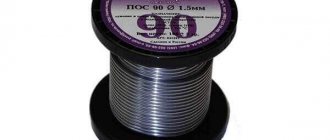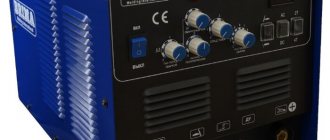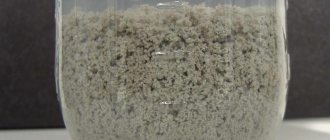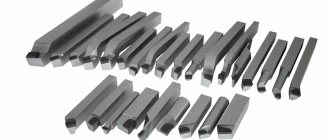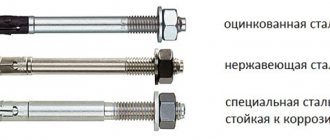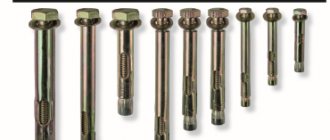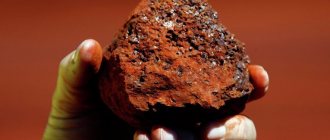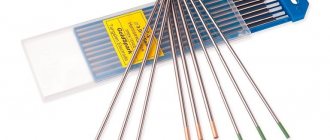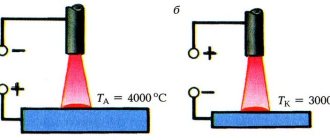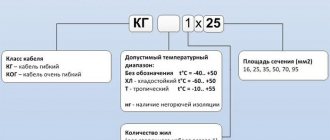Welding electrodes are a rod protected by a special coating. It is also called coating. The coating of the welding electrodes acts as a barrier between the welding zone and the air. It eliminates the oxidative process. The coating is used for all types of electrodes working with both ferrous and non-ferrous metals and alloys.
Why is electrode coating needed?
When determining the composition of the electrode coating, the following series of priority tasks are identified:
- Electrode coating is a special coating. Which protects the welding area of the metal from oxidizing elements such as hydrogen, oxygen and nitrogen. During the welding process, at the point of contact of the electrode with the metal, a two-stage protection is created, which consists of carbon dioxide vapor and carbon monoxide. Which envelop the weld pool, as well as a slag film on the surface of the weld.
- Formation of active crystallization of the weld, preventing cracks and pores. And also the absence of slagging.
- Simplicity of the ignition process and ensuring uninterrupted operation in any operating mode of the welding machine.
- Metal refining by cleaning the weld pool from foreign impurities.
Thus, the electrodes perform important functions, without which the welding process would be more labor-intensive, and in some cases impossible. You can view other necessary information regarding welding technologies on the website mrmetall.ru.
Advice!
When making a purchase in a store, you must inform or indicate the purpose of the electrode coating to the seller. If the electrode is not suitable for its intended purpose, then the metal of the weld will differ from the base metal. This will thereby lead to the appearance of cracks and subsequent deterioration in performance.
Acid coated electrodes
The composition of the coating of acid-coated electrodes contains the highest percentage of silicon, manganese and iron oxides. Acid-coated electrodes can be used for welding with both alternating and direct currents.
However, electrodes with this type of coating have one significant drawback, the formation of so-called “hot cracks”. Acid electrodes do not form pores when welding rusty metal, or, for example, when the welding arc is significantly extended.
Electrode coating production process
The electrode production process typically consists of the following steps:
- Preparing the wire to create a metal rod;
- Preparation of powder coating;
- The process of applying coating to a metal rod;
- Drying and subsequent calcination of finished electrodes.
The finished product is a metal rod coated with a certain powder coating. The electrode coating contains chemical elements that help improve the melting process of the metal rod, as well as the transfer of metal droplets to the area where the weld will be located.
The metal rod production line contains a roller straightening machine, scissors and a winding device. As a result of the operation of these devices, shiny metal rods are obtained from a coil of wire, and this is all without human intervention.
On the chemical powder coating production line, things are a little more complicated. The technological process starts from the ore and chemical warehouses and ends at the location of the large drum mixer. As a rule, to prepare a charge, you need to use a whole chain of mechanisms and equipment. The chain includes: crushing mechanisms, a mill, mixers and separators. The composition of the powder composition primarily depends on the type of electrode coating.
The main device for creating the coating is the drum mixer, in which the process of mixing all the components of the coating occurs. The operation of this unit is to apply a coating composition to the rod along its entire circumference. Next, almost finished products are placed on drying racks. According to the standard, the humidity should be 4% and the drying temperature 30 degrees.
After drying, the calcination process follows. For this purpose, the dried electrodes are fed into the oven. There they are calcined at a temperature of 400 degrees for 4 hours. After the calcination process, each electrode is cut and cleaned on both sides.
Components included in the powder coating or mixture
When creating an electrode coating, different chemical elements are used, each element has special characteristics in the welded area. The components help create a protective layer, which includes: Carbon monoxide and carbon dioxide.
In addition to protection, the components are involved in the formation of a layer of slag, which consists of kaolin, cellulose, starch and others. Under the slag layer, gas is formed, which is formed using: marble, chalk, quartz sand, titanium concentrate and others.
What is the role of binders and other components in the electrode coating?
All components require high-quality displacement between each other and further adhesion around the entire circumference of the metal rod. To do this, binders such as sodium silicate or liquid potassium glass are added to the coating composition.
Interesting!
Liquid potassium glass is nothing more than silicate glue, which plays a significant role in stabilizing the welding arc.
Thus, answering the question, it was revealed that binding components play a critical role in high-quality electrode coating.
Gas-forming
The components of the composition act as a source of gases that are formed when the electrode melts. These components include wood flour, starch, cellulose and marble.
Stabilizing
During the welding process, it is necessary to ensure easy ignition of the electrode. To do this, various potassium compounds are added to the composition of any electrode coating, for example: potassium nitrate, potassium chromate. Also, do not forget that titanium dioxide, barium carbonate and calcium carbonate have good stabilizing characteristics. These components are also added to different electrode coating compositions, which depend on the type of electrode application.
Deoxidizer components
This type of component is needed, first of all, to quickly remove oxygen from the area of the metal where the weld is formed. Deoxidizing components can be titanium, aluminum, molybdenum or chromium.
Which components used in electrode coating are deoxidizers? The above-mentioned components enter into an active reaction with oxygen, and during the bonding process the oxygen elements are seized. The components also have another name - ferroalloys.
Slag-forming elements of the coating composition
In order to indicate the role of slag-forming substances in the electrode coating, you do not need to have chemical knowledge. Everything is quite simple, the slag-forming element serves to protect the metal area by chemically dissolving the oxides of foreign impurities, as well as to reduce the cooling rate of the weld. The slag element can be: fluors and feldspars, rutile, ilmenite and manganese ore.
Alloying components
As a rule, the alloying process helps to improve the performance characteristics of the weld under extreme conditions. The following components can be alloyed: titanium, silicon, manganese, and chromium. Thus, answering the question: “What is the role of alloying elements in the electrode coating?”, it was revealed that if the buyer will operate a product that has undergone a welding process in extreme conditions for it, then it is necessary to take electrodes with a coating that contains alloying elements .
Forming
The content of such components in the electrode coating contributes to increased elasticity during pressing. These components play a big role when applying coating to a metal rod. As a rule, in production they use: bentonite, kaolin and others.
Coloring components
Already from the name it is clear that coloring components are used to color the coating. In order to be able to visually determine the marking of the finished product.
How to apply the coating
As mentioned above, the thickness of the coating directly depends on the diameter of the rod itself. Various technologies can be used to apply such a coating. Coating is applied during their manufacture using special equipment. Such equipment operates in a fully automatic mode, which improves the quality of coating on electrodes. Solid elements in the composition of the coating can be ground and additionally applied to the viscous base of the coating. To ensure a single fraction of such solid components, they are sifted through special filters, and only after that they are applied to the surface of the surfacing material. In some cases, when applying the coating, the finished composition is pre-fired, which makes it possible to remove sulfur, which can deteriorate the quality of the welded joint. At the last stage of coating, the machine dips the rods into the prepared mixture, and at the end we get a uniform layer of coating.
Types (types) of coverage
Electrode coating is divided into several types or types. Each type of coating exists for specific welding operations and, as a rule, depends on the composition of the coating and the metal that will be subjected to the welding process. Perhaps the most asked question to electrode sellers is: “What is the difference between rutile-coated and basic-coated electrodes?” We answer: “To answer this question, it is important to understand that any type of electrode coating differs from another primarily in its composition, and, accordingly, in the method of using the electrode.”
Basic
This type of electrode coating consists of a mixture of calcium and magnesium carbonate, also has another name - an electrode containing a calcium-fluoride coating.
Electrodes with a base coating of grade “B”, as a rule, consist of fluoride compounds. A directed metal is similar in its chemical characteristics to a resting metal. The weld seam gains ductility and increased impact strength. These properties appear thanks to a well-developed composition, in which the content of non-metallic inclusions and gas is reduced, as well as the virtual absence of harmful impurities. The marking used for electrodes with a basic coating must contain the letter “B”!
Basic coated electrodes have proven themselves successfully in the following applications:
- When welding parts of large thickness;
- When welding rigid structures;
- Welding of mild steel with a high content of sulfur, carbon and phosphorus;
- When welding steel types (low alloy and high alloy);
- When welding steel that will be operated at high temperatures and high loads.
Rutile
Electrodes with basic and rutile coatings are distinguished primarily by their composition. In rutile electrodes, the main element in the composition is the mineral Rutile. The composition also contains the following components: magnesium carbonate, ferromanganese, and silica. This brand of electrodes differs from all others by reduced spatter in the welding zone. This makes the seam more uniform and even. The marking of electrodes with rutile coating must contain the letter “P”.
Pulp
This type differs from all others, primarily in its low slag content and large volume of gas during the welding process. Cellulose electrodes marked “C” have earned their popularity in vertical welding. This brand contains: resins, talc, cellulose and ferroalloys. The content of organic elements is at least half of the total composition.
Acid coating
The acid coating of the electrode serves to increase the fluidity of the metal, but thereby increases the risk of undercutting. As a rule, it contains oxides of manganese and iron. The marking contains the letter "A". This type of electrode coating has a drawback, which is the formation of hot cracks.
Rutile-cellulose
Rutile coating of the electrode is marked “RC”. Vertical welding and relatively low spatter, these two points make rutile cellulose electrodes a popular choice among the entire range of electrodes on today's market.
Rutillo-basic
Electrodes with basic coating and rutile differ in a number of ways. But at the same time, there are electrodes marked “RB”, indicating a mixed type. Electrodes with this coating contain all the advantages of the basic and rutile grades.
To summarize, while writing the material, a detailed answer was given to the question: “What is the role of alloying, binding and other elements used in the electrode coating.” There was a good layer of information touched upon that will help the reader begin to understand the range of consumable welding products on today's market.
Coating thickness
Blue coating of electrode brand MR-3S
In addition to the characteristics of the coating applied to the electrode rod and the diameter of the electrode itself, when selecting materials for welding, they also focus on the thickness of the protective coating.
The coating thickness of the electrode rod is the ratio of the overall diameter (D) and the diameter of the internal rod (d). That is, a thicker electrode may have less coating thickness if it has a lower D/d ratio.
Each diameter of the inner rod has its own coating thickness. There are 4 categories of electrodes, differing in coating thickness:
- thin or stabilizing electrodes (the letter M is used to designate them) with a ratio of 1.2 or more;
- middle electrodes (designated C) with a ratio of 1.45 or greater;
- thick , having a ratio less than or equal to 1.8, which are also called high-quality (marked with the letter D);
- especially thick electrodes are also included in the quality category and have a diameter ratio of over 1.8 (can be recognized by the letter G in the marking).
The thickness of the coating of high-quality electrodes ranges from 0.5 to 2.5 mm, which is 20-40% of the mass of the internal rod. If we take iron powder into account, the diameter will be 3.5 mm and the mass fraction will be 50%. Such electrodes are used when a high-quality seam that can withstand heavy loads is needed.
Thin or stabilizing electrodes, the coating thickness of which is approximately 0.1-0.3 mm, make the arc burning smooth and continuous, but do not in any way affect the quality characteristics of the deposited steel.
[ads-pc-3][ads-mob-3]

